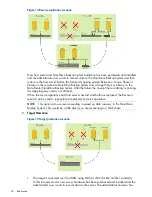
Manager, administrators create, manage, and remove groups of devices; and establish and control
user and administrator access to the groups and devices. Replication Manager allows administrators
and users to review the status of the groups and devices to which they have access, either to ensure
that replication is happening successfully and on schedule, or to respond when there are replication
operation errors. Replication Manager also provides the ability to monitor disk usage and
deduplication ratios for the devices. This allows administrators the ability to identify devices that
may need additional capacity. Trend analysis is also available to look at disk capacity changes
that occur on devices over a pre-determined period.
To find out more about Replication Manager, see HP Replication Manager User Guide at
www.hp.com/go/d2d
. To install Replication Manager and the documentation, see HP Replication
Manager Installation and Configuration Guide, also at
www.hp.com/go/d2d
.
Replication concepts and terminology
When configuring appliances for replication, there are some key concepts and terminology that
it is important to understand.
Replication elements
•
Source Appliance:
This is the StoreOnce Backup System with the NAS share or library device
that is being used for backup by a host server. The NAS share contains data files that need
to be replicated; the library device contains slots that need to be replicated.
•
Target Appliance:
This is the StoreOnce Backup System with the NAS share or library device
that contains the replicated data; it is an exact match of the NAS share or library on the source
StoreOnce Backup System. This appliance needs a replication license.
•
Non-Replicating Device:
This describes a NAS share or library on a StoreOnce Backup System
that has not been configured as a source or target for replication.
•
Replication-Source Device:
This describes the NAS share or library on a StoreOnce Backup
System that has been configured for backups from a host server and has also been configured
for replication. Replication-Source shares and libraries are visible to the host.
•
Replication-Target Device:
This describes the NAS share or library on a StoreOnce Backup
System that has been configured to contain data replicated from a source library. The
Replication-Target share is visible to the host, but Replication-Target libraries are not visible
to the host, unless you configure devices to make it visible. See the HP StoreOnce Backup
System user guide for more information.
A single HP StoreOnce Backup System may host both Replication-Source and Replication-Target
shares and libraries and can, therefore, act simultaneously in both Source and Target Appliance
roles. However, the host server will only be able to access Replication-Source or Non-Replicating
Libraries. You can configure Replication—Target Libraries to make them visible (read-only). There
is no restriction on the host accessing Replication-Target NAS shares.
24
Replication















































